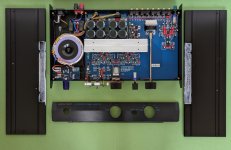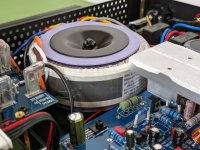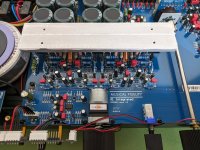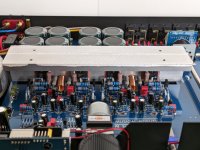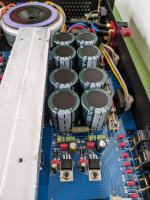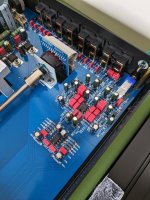This time indeed WITH the really useful speaker protection🙂
Construction seems to be very much like the wellknown older A1. First weak spots are of course the TL072 opamps. There can be pages filled about opamps and personal preferences but these are sub standard.
Had a cheap class D amplifier over for testing. A comparison with A1 2023 would be nice.
Construction seems to be very much like the wellknown older A1. First weak spots are of course the TL072 opamps. There can be pages filled about opamps and personal preferences but these are sub standard.
Had a cheap class D amplifier over for testing. A comparison with A1 2023 would be nice.
Last edited:
Yeah the TL072 really is a strange choice. Even an NE5532 would be a major improvement in the line stages for very few pennies.
My first listening impression:
good, very enriched with too fresh mids, lacking blackness in the sound, hotter than the eighties original.
However, what I absolutely don't understand about H. Lichtenegger's great throw (achievement) is that the weak points of the original were adopted almost 1 to 1. So it must be a cunning marketing gag.
Completely inconsistent, the device gets even hotter than the original, why?
Because
1. we do not find 230Vac but 240Vac everywhere as mains voltage, a fact that with the 19vac secondary windings leads to +/-27Vdc rails, i.e. at least 86Wrms are converted into heat ..!
Ok, the surface area of the cover is slightly larger than the original, but its convection capabilities are hugely limited - and always have been.
Why doesn't H. Lichtenegger give the device a little more volume, perhaps 15mm more internal height, more air - and provide ventilation slots or holes on the rear panel, perforate the entire base, raise the feet by 5mm, increase the efficiency of the heat sink cover ..! ?
2. more losses than before!
good, very enriched with too fresh mids, lacking blackness in the sound, hotter than the eighties original.
However, what I absolutely don't understand about H. Lichtenegger's great throw (achievement) is that the weak points of the original were adopted almost 1 to 1. So it must be a cunning marketing gag.
Completely inconsistent, the device gets even hotter than the original, why?
Because
1. we do not find 230Vac but 240Vac everywhere as mains voltage, a fact that with the 19vac secondary windings leads to +/-27Vdc rails, i.e. at least 86Wrms are converted into heat ..!
Ok, the surface area of the cover is slightly larger than the original, but its convection capabilities are hugely limited - and always have been.
Why doesn't H. Lichtenegger give the device a little more volume, perhaps 15mm more internal height, more air - and provide ventilation slots or holes on the rear panel, perforate the entire base, raise the feet by 5mm, increase the efficiency of the heat sink cover ..! ?
2. more losses than before!
I didn't like that A1 (I had a clone - not the original) - when exceeding a couple of W, the oscillograph clearly showed the switching distortions in the sinusoid at high frequencies - it is also visible in the thd vs power graph (asr ) when after a couple of W the distortion increases..
After 2 hours, the front panel also became extremely hot, which the gearing of the motor potentiometer doesn't like at all. The result is a very unpleasant noise of complaint when the µC is commanded to move the potentiometer.
This is almost a good reason to advise against this (actually) very beautiful classic.
I would like to see a revision of this classic that is actually a revision - not just a new edition with a new PCB and TIP35C / TIP36C.
The user manual supplied is a very, very bad joke.
By the way
an A1 can never have a damping factor of 150, nor can this new reissue deliver 25A load current ...
20 real pp class A watts are also not possible, there are only just under 16 at 8 ohms.
and so on.
For technically experienced and courageous owners of this gem, a lot of work awaits. In its current delivery state, the first device will fail completely after 2 years at the latest. Exactly as it was almost 40 years ago - a pity.
Specifying +/-1 dB RIAA accuracy is also very, very bad. Even with /and especially with this equalizer, 0.3dB deviation is possible without any problems. Only the switching between MM and MC cancels it out /or limits it. Why? That's going too far here.
Conclusion:
A rather expensive classic, with all the weaknesses of the original and these have even been improved, the weaknesses.
Basically, the appliance must stand completely free, there must be nothing above the lid, not even at a distance of 26 cm (see installation guide = user manual).
It is an exotic product that is best used only in winter, in an ice-cold log cabin. Class A is not to be confused with an electric hob - but apparently this is supposed to be the gimmick.
HBt.
This is almost a good reason to advise against this (actually) very beautiful classic.
I would like to see a revision of this classic that is actually a revision - not just a new edition with a new PCB and TIP35C / TIP36C.
The user manual supplied is a very, very bad joke.
By the way
an A1 can never have a damping factor of 150, nor can this new reissue deliver 25A load current ...
20 real pp class A watts are also not possible, there are only just under 16 at 8 ohms.
and so on.
For technically experienced and courageous owners of this gem, a lot of work awaits. In its current delivery state, the first device will fail completely after 2 years at the latest. Exactly as it was almost 40 years ago - a pity.
Specifying +/-1 dB RIAA accuracy is also very, very bad. Even with /and especially with this equalizer, 0.3dB deviation is possible without any problems. Only the switching between MM and MC cancels it out /or limits it. Why? That's going too far here.
Conclusion:
A rather expensive classic, with all the weaknesses of the original and these have even been improved, the weaknesses.
Basically, the appliance must stand completely free, there must be nothing above the lid, not even at a distance of 26 cm (see installation guide = user manual).
It is an exotic product that is best used only in winter, in an ice-cold log cabin. Class A is not to be confused with an electric hob - but apparently this is supposed to be the gimmick.
HBt.
I like him too, but I've known him inside out since the early 1990s.I didn't like that A1 (I had a clone - not the original) - when exceeding a couple of W, the oscillograph clearly showed the switching distortions in the sinusoid at high frequencies - it is also visible in the thd vs power graph (asr ) when after a couple of W the distortion increases..
Nevertheless, CEO Heinz L. with MF has missed a really, really big opportunity here /in this case. They are simply referring to the original. Good, but nowadays nobody wants to have the dangerous quirks of the original, do they?
Top sound, but not suitable for year-round enjoyment, but only to impress his buddies once - we are actually looking for flawless.
It is still fun and also a challenge to our modification skills, abilities and understanding.
HBt.
As expected but still a pity.
You wrote “a lot of work” needs to be done but one would suppose no work needs to be done for that price. The company could have easily avoided making the same errors again. Probably people that dream of the past will still buy it.
You wrote “a lot of work” needs to be done but one would suppose no work needs to be done for that price. The company could have easily avoided making the same errors again. Probably people that dream of the past will still buy it.
Last edited:
Exactly. And it would have been so easy.Expected but still a pity.
Yes, you're right about that - but Tim de Paravincini's idea has a lot of potential. It's just that MF's implementation is actually rubbish, rubbish that has become an icon.I didn't like that A1
That's absolutely right and I agree with you on all of these points.You wrote “a lot of work” needs to be done but one would suppose no work needs to be done for that price. The company could have easily avoided making the same errors again. Probably people that dream of the past will still buy it.
CEO and MF could have done themselves a favor, but unfortunately they didn't.
I also advise against buying it,
unless you are able to handle the thing (and you need a lot of knowledge and skill for that) and can somehow get over the far too high purchase price - buy the exotic for other reasons.
If you have access to the original service documents of the current event /A1, please post them here anonymously or send them to me, I only have the ancient original hand drawing of the A1.
Yo , if you stumble on Alchemist Kraken in hammer tone green on the junkyards looking for that plastic MF let me know ...
Does this mean that the gizmo is a bad copy, a plagiarism of the MF-A1?Yo , if you stumble on Alchemist Kraken in hammer tone green on the junkyards looking for that plastic MF let me know ...
Even if the circuit is strictly forward, does anyone have the current plans, i.e. service documents on hand?
Please share.
🙂
Please share.
🙂
I repaired an original for a friend when I lived in Taiwan. Very nice sounding amp but the implementation in some areas was abysmal- undersized heatsink, that volume control and input selection setup 🤦♂️
undersized heatsink
I had an unit ages ago [so, the 1st (european) series], but if I had it now I wouldn't resist putting a heatsink like this onto it
A single piece cut to size for the entire size of the top cover for about 115 bucks (+ shipping) from here and I would have a lot of fun fun modifying it! 😍
On the two sides I would put a fully perforated sheet metal too.
- Home
- Amplifiers
- Solid State
- 2023 Musical Fidelity A1
